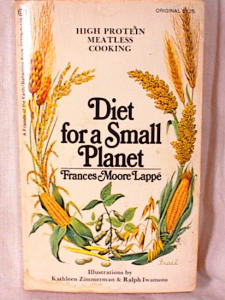Diet for a Small Planet facts for kids
 |
|
| Author | Frances Moore Lappé |
|---|---|
| Illustrator | Kathleen Zimmerman and Ralph Iwamoto |
| Country | United States |
| Subject | Cookbook, vegetarianism |
| Publisher | Ballantine Books |
|
Publication date
|
1971 |
| Pages | 301 |
| ISBN | 9780307874313 |
| OCLC | 247743 |
| 641.6/3/1 | |
| LC Class | TX392 .L27 |
Diet for a Small Planet is a super important book written in 1971 by Frances Moore Lappé. It was one of the first books to explain how raising animals for meat can actually hurt our planet. It also showed how this can make it harder for everyone to have enough food. The book encourages something called environmental vegetarianism. This means choosing to eat mostly plant-based foods because you care about the environment and how animal farming affects it.
Over three million copies of this book have been sold! It was a big deal because it said that people go hungry not because there isn't enough food, but because of how food is managed around the world. Besides talking about meat production and hunger, the book also gives easy tips for eating healthy. Plus, it has hundreds of delicious recipes that don't use meat.
What's Inside the Book?
The book is divided into different parts to help you understand its ideas:
- Part I: Earth's Labor Lost – This part looks at how protein is produced in big farms in the United States.
- Part II: Bringing Protein Theory Down to Earth – This section explains how protein works in our bodies.
- Part III: Eating From the Earth: Protein Theory Applied – Here, you'll find tables about food values and how protein relates to energy and cost.
- Part IV: Combining Non-Meat Foods to Increase Protein Values – This part gives you helpful guidelines and many recipes.
- The book also includes extra sections like Appendices, Notes, and an Index.
Understanding Protein from Plants
When the book first came out, many people wondered if a vegetarian diet could give you enough protein. So, a big part of the book teaches about "protein combining." This idea suggests eating different plant foods together. The goal is to make sure their combined amino acid pattern matches what our bodies need. This is called "net protein utilization." The main idea was to combine foods like dairy with grains, grains with legumes, or legumes with seeds.
However, Frances Moore Lappé later realized that getting enough protein from plants is easier than she first thought. In the 1981 version of her book, she explained:
"In 1971, I focused on protein combining. I thought it was the only way to get protein that our bodies could use as well as animal protein. While trying to show that meat isn't the only way to get good protein, I accidentally made people think it was really hard. I gave the impression that you needed to be very careful choosing foods to get enough protein without meat. Actually, it is much easier than I thought."
She added that it's very rare to have a protein shortage on a plant-based diet. This is true as long as you eat enough calories overall. The only exceptions might be diets that rely almost entirely on fruit, certain tubers like sweet potatoes or cassava, or mostly junk food. Luckily, most people eat a wider variety of foods.
Many traditional ways of cooking around the world naturally combine grains and legumes. For example, in Latin America, people eat beans with tortillas or rice. In the Middle East, you might find bulgur wheat with chickpeas, or pita bread with falafel and hummus. In Asia, soy is often eaten with rice, wheat, or millet. These combinations show how different plant foods can work together.
The first edition of Diet for a Small Planet was supported by the Friends of the Earth group. Later, a cookbook called Recipes for a Small Planet was released, with an introduction by Lappé. There was also a film made to share Lappé's important message.
The Book's Lasting Impact
In 1975, Frances Moore Lappé and Joseph Collins started an organization called the Institute for Food and Development Policy (also known as Food First). Their goal was to teach people in America about the real reasons behind world hunger.
The book also helps us understand the link between food production and climate change.

